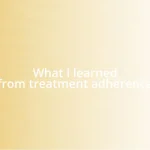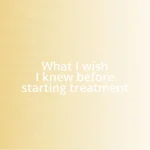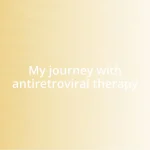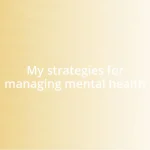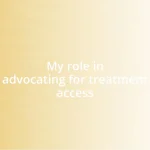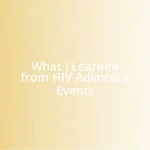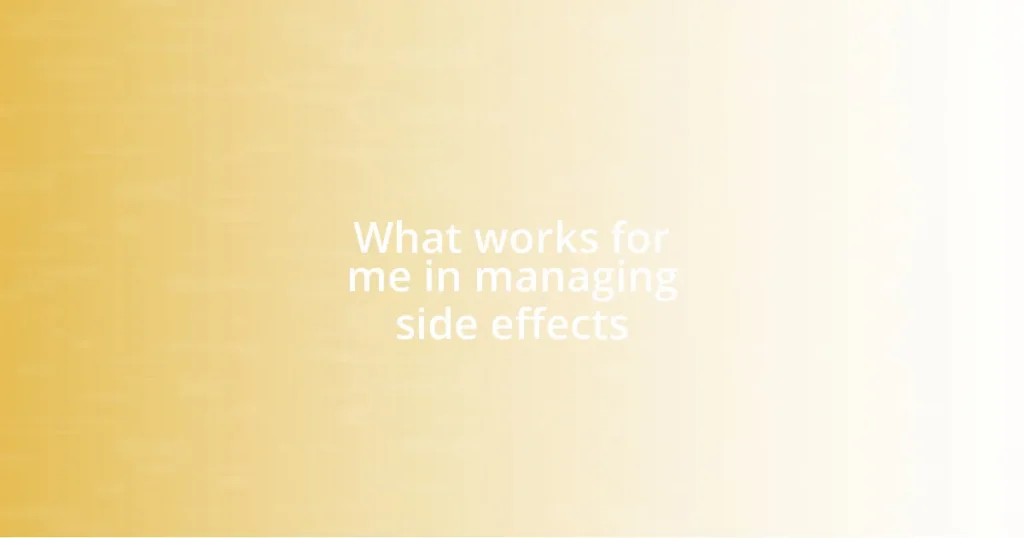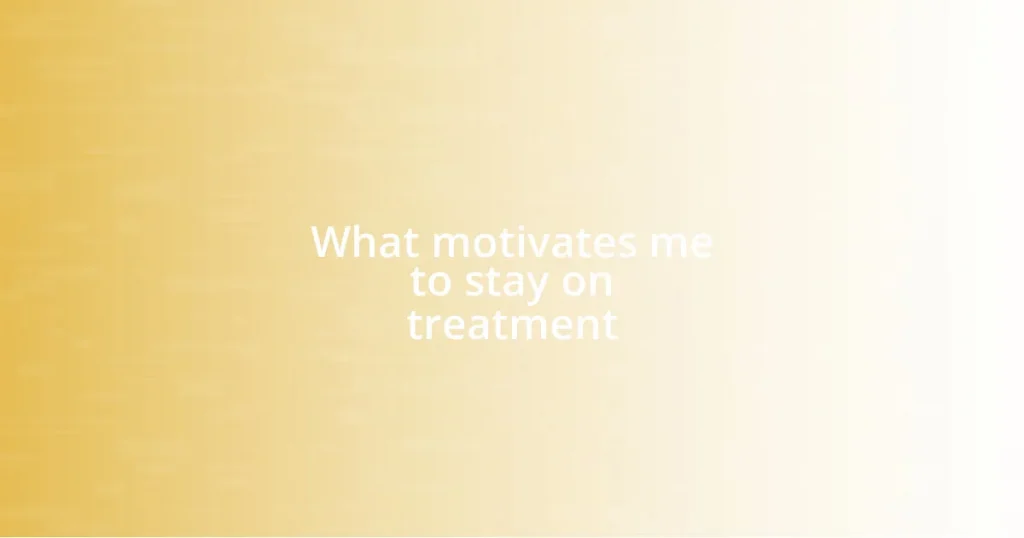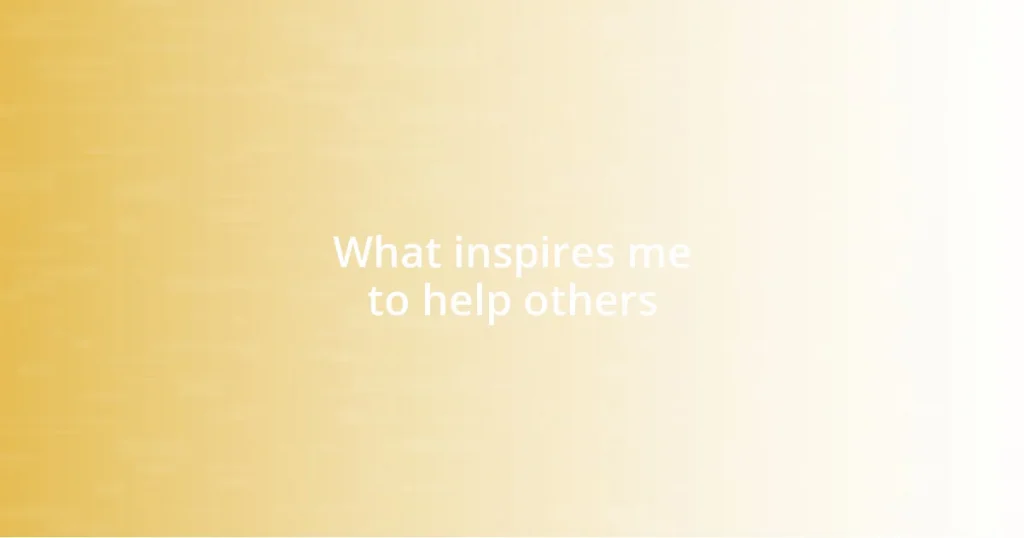Key takeaways:
- Effective HIV community engagement requires genuine connections through listening, empathy, and fostering a sense of belonging.
- Identifying and empowering key community stakeholders, including marginalized voices, enhances collaborative efforts in addressing HIV issues.
- Utilizing inclusive language, visual storytelling, and feedback loops in communication strategies helps build trust and encourages open dialogue.
- Social media serves as a powerful platform for raising awareness and fostering emotional resonance through relatable content and creativity.

Understanding HIV Community Engagement
Understanding HIV community engagement goes beyond simply sharing information; it’s about forging genuine connections. I remember attending a small local forum where people openly shared their stories, and it struck me how powerful it was to see individuals from different backgrounds unite for a common cause. Have you ever felt that electric atmosphere when conversations turn into collective action?
In my experience, effective engagement hinges on listening—truly listening—to the voices within the community. There was a moment during one outreach event where a participant opened up about the stigma of HIV, and it was a reminder that real understanding requires empathy. How can we address issues if we aren’t fully aware of the lived experiences that shape them?
Moreover, fostering a sense of belonging is crucial when tackling sensitive topics like HIV. I’ve seen community art projects transform into platforms for advocacy, allowing participants not just to express their struggles but also to champion their resilience. Isn’t it fascinating how creativity can ignite conversations that lead to meaningful change?

Identifying Key Community Stakeholders
Identifying key community stakeholders is essential for effective engagement in HIV issues. From local health organizations to grassroots activists, each stakeholder plays a unique role in addressing the epidemic. I vividly recall a community meeting where local health providers shared their insights, revealing how critical their positions are in shaping responses to HIV. It made me realize the depth of connection between service providers and the communities they serve. Have you ever thought about how these relationships can amplify collective action?
Engaging with stakeholders goes beyond just knowing who they are; it’s about understanding their motivations and challenges. During one initiative, I worked closely with a few community leaders who were passionate but felt overwhelmed. Listening to their stories of struggle stressed how essential it is to empower these individuals. When we take the time to understand their perspectives, it lays the groundwork for effective collaboration and trust.
To truly identify the key players, we should also consider marginalized voices that often go unheard. While conducting some outreach, I came across individuals from communities disproportionately affected by HIV but overlooked in mainstream discussions. It was a powerful reminder that without their input, our strategies risk being incomplete. Who can we support to make their voices resonate in the larger conversation?
| Stakeholder Type | Role in Community |
|---|---|
| Local Health Organizations | Provide essential services and resources |
| Grassroots Activists | Mobilize communities and advocate for change |
| Marginalized Voices | Highlight unique challenges within the community |

Developing Effective Communication Strategies
Developing effective communication strategies in the context of HIV issues requires an approach that resonates deeply with community members. I think about a workshop I facilitated, where participants shared their thoughts on what language felt inclusive versus exclusionary. It was enlightening to realize how just a couple of words could shift someone from feeling marginalized to empowered. Isn’t it amazing how the right phrasing can open up conversations?
Key components of effective communication strategies include:
- Active Listening: Engage with the community by truly hearing their concerns and feedback.
- Inclusive Language: Use terminology that respects diverse identities and experiences.
- Visual Storytelling: Incorporate images or videos that depict real-life narratives, making the issues relatable.
- Feedback Loops: Create opportunities for community members to provide input on programs or initiatives, ensuring they feel valued.
- Culturally Relevant Messaging: Tailor messages to reflect the cultural context of the community, making them more impactful.
I’ve also learned that delivering information in accessible formats is vital in bridging gaps in understanding. During a community fair, I noticed how a simple pamphlet in plain language sparked conversations, illuminating misconceptions about HIV transmission. One senior participant candidly mentioned that she had been afraid to ask questions for years. That moment emphasized how clarity can dismantle the walls of fear and stigma.
To engage effectively, consider these strategies:
- Community Workshops: Provide spaces for open dialogue and shared learning experiences.
- Social Media Campaigns: Leverage platforms to disseminate clear and supportive messaging.
- Local Partnerships: Collaborate with trusted community figures to help convey essential information authentically.
- Interactive Platforms: Implement Q&A sessions or forums where individuals can voice concerns without fear of judgment.
- Consistent Updates: Maintain ongoing communication to keep the community informed and engaged with current initiatives.

Building Trust within Communities
Building trust is paramount when engaging communities in HIV issues. I remember a local outreach event where I simply sat down with a group of residents over a cup of coffee. We talked about their concerns and experiences with healthcare access, and honestly, it felt more like a heart-to-heart than a formal meeting. In those moments, sharing vulnerabilities can foster a deeper connection. Have you ever realized that simply being present can dismantle barriers?
It’s essential to show up consistently in community spaces and be reliable. During another initiative, I volunteered at a local health fair, where I learned that trust isn’t built overnight. One participant approached me hesitantly, recounting previous negative experiences with health services. That interaction taught me how critical it is to prove our commitment through action. When communities see dedicated efforts over time, they begin to let down their walls. How can we ensure our presence is felt, even when we’re not actively engaged?
Recognizing and honoring community traditions also plays a crucial role in building trust. I once attended a cultural event where local leaders emphasized collective care and responsibility. Their stories underscored how intertwined our efforts need to be with roots and history. When we respect and integrate these elements, we not only create authentic relationships but also establish a foundation for meaningful dialogue. What aspects of community culture can we highlight to strengthen our connections?

Organizing Community Outreach Programs
Organizing community outreach programs requires a sensitive understanding of the local dynamics. One vivid memory that stays with me is when I helped plan a health screening event in a neighborhood that had previously felt underserved. We collaborated with local leaders, which made all the difference; it felt as if the community was taking ownership of the outreach. Seeing residents come together, sharing their stories and knowledge about health resources, was incredibly rewarding. Isn’t it fascinating how ownership can lead to empowerment?
It’s essential to create an environment that welcomes open discussion. I often think back to a small gathering we organized in a local park, where we encouraged attendees to share their experiences with HIV-related stigma. The turnout surprised me, and the honesty of those conversations left a lasting impression. It became clear that fostering these safe spaces allows for authentic dialogue and, ultimately, drives more engagement. How often do we underestimate the power of a friendly atmosphere?
Moreover, integrating fun activities can enhance participation. I recall an outreach program that included health trivia games and creative art projects focused on HIV awareness. The atmosphere was lively, and people were not just learning; they were enjoying themselves while absorbing crucial information. Seeing families participate together emphasized how outreach can be both informative and delightful. Don’t you think creativity plays a vital role in connecting with diverse audiences?

Leveraging Social Media for Awareness
Social media has become a powerful tool for raising awareness about HIV issues. I vividly remember the first time I tweeted about a local HIV awareness campaign. The immediate response was overwhelming; people started sharing their own stories, and suddenly, we had ignited a conversation that reached far beyond my small circle. Isn’t it amazing how a single post can connect us to so many individuals who are experiencing similar challenges?
Engaging communities via social media requires authenticity and understanding. I’ve learned that sharing relatable content—like personal testimonials or local community events—can create an emotional resonance that statistic-laden posts just can’t achieve. One evening, I crafted a Facebook post featuring a video of a local advocate discussing her journey with HIV. The comments flooded in with words of support and encouragement. It reminded me that vulnerability can breed connection. How often do we forget that real people behind these issues matter more than the numbers?
Moreover, utilizing platforms like Instagram can visually resonate with audiences, especially younger generations. When I collaborated with local artists to create a series of eye-catching infographics about HIV prevention, I was pleasantly surprised by the engagement that followed. The vibrant images caught the attention of those who typically scrolled past health messages. Isn’t it intriguing that creativity can turn a serious topic into something visually inviting, encouraging people to learn more?

Evaluating Engagement Impact and Feedback
Evaluating the impact of community engagement on HIV issues is crucial for understanding what resonates and what doesn’t. During one assessment, I gathered feedback from attendees of a forum we organized. It was eye-opening to realize that many participants felt more empowered to discuss HIV after witnessing their friends share similar stories. This feedback made it clear that engagement is not just about information—it’s about building a community that encourages vulnerability.
One time, we implemented anonymous surveys post-event, hoping to gauge the emotional and educational impact of our outreach efforts. The responses shared a range of emotions, from relief to newfound confidence. I remember reading one response from a young man who said, “For the first time, I felt seen and heard.” These moments are invaluable; they remind me that engagement is deeply personal and that feedback loops can shape future efforts in meaningful ways. Isn’t it fascinating how a few honest words can illuminate the path forward?
Additionally, I’ve found that tracking social media interactions can provide rich insights into how engaged the community really feels. After one campaign, I noticed a spike in discussion around a specific post, prompting me to dive deeper. I reached out to those who interacted the most and discovered their desire for more direct involvement. This experience taught me that sometimes, the best feedback comes from genuine conversations sparked by engagement, and it keeps me eager to explore new avenues for connection. Wouldn’t you agree that listening closely to the community is where the real magic happens?



